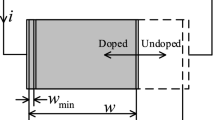Abstract
The notion of memristive system was first proposed in 2009. This concept of memory element has been extended from memristors \((\hbox {R}_{\mathrm{M}})\) to memcapacitors \((\hbox {C}_{\mathrm{M}})\) and meminductors \((\hbox {L}_{\mathrm{M}})\). Currently, the above elements are not available as off-the-shelf components. Therefore, based on the realization of a light-dependent resistor (LDR), memristor analog model, memcapacitor and meminductor analog circuit models based on \(\hbox {R}_{\mathrm{M}}-\hbox {C}_{\mathrm{M}}\) and \(\hbox {R}_{\mathrm{M}}-\hbox {L}_{\mathrm{M}}\) converters are first introduced. Then, instead of the traditional resistor, capacitor, and inductor, memristor-, memcapacitor-, and meminductor-equivalent circuits are used to determine the time domain characteristics of the RLC-mode circuits with mem-elements. These circuits are discussed in detail, and in particular, the phenomena caused by the memory characteristics of the mem-elements are studied. This research provides an important reference for further research into mem-element applications in circuit theory.














Similar content being viewed by others
References
S. Avantika, G. Gaurav, Circuit mimicking TiO\(_2\) memreistor: a plug and play kit to understand the forth passive element. Int. J. Bifurc. Chaos 20, 2537–2545 (2010)
D. Biolek, Z. Biolek, V. Biolkova, Spice modeling of memcapacitor. Electron. Lett. 46, 520–522 (2010)
D. Biolek, Z. Biolek, V. Biolkova, PSPICE modeling of meminductor. Analog Integr. Circuits Signal Process. 66, 129–137 (2010)
Z. Biolek, D. Biolek, V. Biolkova, SPICE model of memristor with nonlinear dopant drift. Radioengineering 18, 210–214 (2009)
L.O. Chua, Memristor—the missing circuit element. IEEE Trans. Circuit Theory 18, 507–519 (1971)
L.O. Chua, Memristor and Memristive Systems Symposium, vol. 21 (University of California Berkeley, Berkeley, 2008)
H. Kim, M. Sah, C. Yang, S. Cho, L.O. Chua, Memristor emulator for memristor circuit applications. IEEE Trans. Circuits Syst. I Regul. Pap. 59(10), 2422–2430 (2012)
Y. Liang, D.S. Yu, H. Chen, A novel meminductor emulator based on analog circuits. Acta Phys. Sin. 62, 158501 (2013)
J. Markoff, Reports big advance in memory chip design [2008-05-01]. http://www.nytimes.com/2008/05/01/technology/01chip.htm
Y.V. Pershin, S.L. Fontaine, M.D. Ventra, Experimental demonstration of associative memory with memristive neural networks. J. Neural Netw. 23, 881–886 (2010)
Y.V. Pershin, M.D. Ventra, Practical approach to programmable analog circuits with memristor. IEEE Trans. Circuits Syst. I Regul. Pap. 57, 1857–1864 (2010)
J. Valsa, D. Biolek, Z. Biolek, An analogue model of the memristor. Int. J. Numer. Model. Electron. Netw. Devices Fields 24, 400–408 (2010)
M.D. Ventra, Y.V. Pershin, L.O. Chua, Putting memory into circuit elements: memristors, memcapacitors and meminductors. Proc. IEEE 97, 1371–1372 (2009)
X.Y. Wang, A.L. Fitch, H.H.C. Iu, V. Sreeram, W.G. Qi, Implementation of an analog model of memristor based on light dependent resistor. Chin. Phys. B 21, 108501 (2012)
X.Y. Wang, A.L. Fitch, H.H.C. Iu, V. Sreeram, W.G. Qi, Design of a memcapacitor emulator based on a memristor. Phys. Lett. A 396, 394–399 (2012)
Acknowledgments
This research is supported by the National Natural Science Foundation of China (Nos. 61401134, 61271064), the National Natural Science Foundation of Zhejiang Province (Nos. LQ14F010008, LZ12F01001), the Scientific Research Starting Foundation for Hangzhou Dianzi University (No. KYS045613020), and the Open Foundation of Hangzhou Dianzi University. (No. GK140201207003/012)
Author information
Authors and Affiliations
Corresponding author
Rights and permissions
About this article
Cite this article
Wang, X., Iu, H.H.C., Wang, G. et al. Study on Time Domain Characteristics of Memristive RLC Series Circuits. Circuits Syst Signal Process 35, 4129–4138 (2016). https://doi.org/10.1007/s00034-016-0250-6
Received:
Revised:
Accepted:
Published:
Issue Date:
DOI: https://doi.org/10.1007/s00034-016-0250-6




